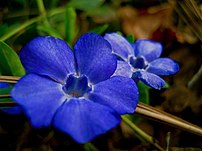
Botanical Name:Catharanthus roseus (L.) G. Don (Apocynaceae)
Family: Apocynaceae
Genus: Catharanthus
G.Don
Syn: Lochnera rosea (L.) Spach, Vinca rosea L.
English names: Madagascar periwinkle, Old maid, Red periwinkle.
Vernacular names: Ben: Nayantara; Hin : Sada sawagon; Lad: Swet chandu; Mal: Mar: Ushamalari;Sadaphul; Ori : Ainskati; Pun: Rattanjot; Tam: Sudukadu Mallikai; Tel: Billaganneru.
Trade name: Nayantara.
Habitat:A native of West Indies; commonly grown in gardens throughout India;Bangladesh and Pakistan.
Description:An evergreen shrub, it grows to a height of 1m with a spread of 1m. The stem is short, erect and branching; the leaves are glossy gree, oval, 5cm long and opposite acuminate; the flowers are soft pink, tinged with red, 5 petalled, open, tubular and 4cm across, appearing in spring and autumn.
You may click to see the pictures..>...(01)…….(1)..…..(2)…….(3)
Catharanthus coriaceus Markgr. Madagascar: A native of tropical Africa and Madagascar, it prefers rich, well drained, moist soils in a protected, sunny position, and is drought and frost tender.
Propagation is by seed and by cuttings.
A small herb or subshrub, up to 75 cm high; leaves elliptic-ovate to oblong, 4-10 by 2-4 cm, glabrous to puberulous, base acute or cuneate, apex obtusely apiculate, lateral nerves 10-12 pairs, petiole 1.0-1.5 cm; flowers in axillary or terminal cymes; solitary or paired, shortly pedicellate, pink or white or white with pink or yellow ring in orifice region; mericarps 3-4 by 0.3 cm, puberulous.
Flowering and Fruiting: throughout the year.
Catharanthus (Madagascar Periwinkle) is a genus of eight species of herbaceous perennial plants, seven endemic to the island of Madagascar, the eighth native to the Indian subcontinent in southern Asia.
Species :
Catharanthus coriaceus Markgr. Madagascar.
Catharanthus lanceus (Bojer ex A.DC.) Pichon. Madagascar.
Catharanthus longifolius (Pichon) Pichon. Madagascar.
Catharanthus ovalis Markgr. Madagascar.
Catharanthus pusillus (Murray) G.Don. Indian subcontinent.
Catharanthus roseus (L.) G.Don. Madagascar.
Catharanthus scitulus (Pichon) Pichon. Madagascar.
Catharanthus trichophyllus (Baker) Pichon. Madagascar.
Ecology and cultivation: Plains from the coasts, in wastelands, fallow fields, less on the hills 800-1400 m, also widely cultivated.
The species are self-propagating from seed; the seeds require a period of total darkness to germinate. Cuttings from mature plants will also root readily.
One species, C. roseus, has been widely cultivated and introduced, becoming an invasive species in some areas.
Chemical contents : Root-bark: vincaline I & II; Root: vinblastine or vinleukoblastine (VLB), vincristine or vinleurocristine (VCR), ursolic acid, oleanolic acid, ajmalicine, alstonine; Stem: vinca rodine, vincoline, vinamidine,leurocolombine, vincathicine, vincubine; Leaf: leurosine, vindoline, catharanthine, lochnerine, tetrahydroalstonine, roseoside, essential oil; Seed: vincedine, vincedicine, tabersonine.
Medicinal Uses:
C. roseus has gained interest from the pharmaceutical industry; the alkaloids vincristine and vinblastine from its sap have been shown to be an effective treatment for leukaemia. Although the sap is poisonous if ingested, some 70 useful alkaloids have been identified from it. In Madagascar, extracts have been used for hundreds of years in herbal medicine for the treatment of diabetes, as hemostatics and tranquilizers, to lower blood pressure, and as disinfectants. The extracts are not without their side effects, however, which include hair loss.
In 1923, considerable interest was aroused in the medical world by the statement that this species of Vinca had the power to cure diabetes, and would probably prove an efficient substitute for Insulin, but V. major has long been used by herbalists for this purpose. Vincristine, a major chemotherapy agent for leukemia, and vinblastin (for Hodgkin’s disease) are derived from the plant. The anti-cancer constituents are very strong and should only be taken under the supervision of a qualified health care practitioner. Use as a fluid extract. It has also been used in traditional herbal medicine to treat wasp stings (India), stop bleeding (Hawaii), as an eyewash (Cuba), and to treat diabetes (Jamaica); contains the alkaloid alstonine which can reduce blood pressure.
Vinca alkaloids:
Vinca alkaloids are anti-mitotic and anti-microtubule agents. They are nowadays produced synthetically and used as drugs in cancer therapy and as immunosuppressive drugs. These compounds are vinblastine, vincristine, vindesine and vinorelbine. Periwinkle extracts and derivatives, such as vinpocetine, are also used as nootropic drugs.
Catharanthus lanceus contains up to 6% yohimbine in its leaves
Indian Traditional use: BODO: (i) Plant: in cancer, diabetes, (ii ) Leaf: in menorrhagia; LODHA : (i) Root-paste: in septic wounds, (ii) Root-decoction (with paste of long peppers) : in fever, (iii) Leaf-juice: in blood dysentery, (iv) Leaf-decoction: to babies in gripping pain; SANTAL : (i) Latex: in scabies, (ii) Seed-powder (with decoction of black pepper) : in epilepsy; ETHNIC COMMUNITIES OF EAST GODAVARI DISTRICT: Root: in cancerous wounds.
Modern use: Plant-extract: antimitotic; Root (alkaloids) : in cancer, and as emetic, hypotensive, sedative and antiviral.
Click to learn more:->
MADAGASCAR PERIWINKLE (Vinca rosea, Linn.)
Catharanthus roseus (Madagascar Periwinkle)
.Description and Natural History of the Periwinkle
Vinblastine and vincristine are alkaloids found in the Madagascar periwinkle
Disclaimer:
The information presented herein is intended for educational purposes only. Individual results may vary, and before using any supplements, it is always advisable to consult with your own health care provider
Resources:
http://en.wikipedia.org/wiki/Madagascar_periwinkle
http://www.bsienvis.org/medi.htm#Bauhinia%20vahlii
http://shaman-australis.com.au/shop/index.php?cPath=21_26_66
http://www.herbnet.com/Herb%20Uses_LMN.htm
































![Reblog this post [with Zemanta]](https://i0.wp.com/img.zemanta.com/reblog_e.png?w=580)